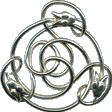Memoirs of Lloyd Moss: 1927
When New Year's Eve came up I thought I would go to the nicest dance hall around and that occurred to me to be the Crystal Ballroom out on Revere Beach. All the big name orchestras in the twenties appeared there sooner or later and it was a very pretty place located just above the beach. Not long after I went in I saw a girl that I thought I would like to dance with and when the music started and she was still sitting there I got up the nerve to walk across the floor and asked her if she would like to dance. And so in effect began the dance of my life that still continues forty-seven years later. We danced several times that night, and I was vaguely aware that there was a fellow around that was her escort but I paid no attention to him. I asked and got the girl's name and address, scribbled it down on a slip of paper, lost the paper but got her address again when she was standing in line at the coat check-room at the end of the evening.
Within a couple of days the Marblehead was again on its way south to Guantanemo, and the usual battle practice maneuvers. But it didn't last long this time. There was big trouble in Nicaragua so we started across the Gulf of Mexico at high speed. The ship's landing party of sailors, since we had no marines on board, got organized and held practice sessions with machine guns on the fantail deck aft. One wild bullet made a hole in the hollow iron flagstaff. So we arrived off the coast at a point called Bluefields, anchored well out from shore in water that seemed as rough as the mid-Atlantic no matter how calm the weather was. It made for a very uncomfortable anchorage. The landing force was sent ashore in whaleboats and then we got underway again and slowly cruised north up the coast as far as Puerto Cabezas (Bragman's Bluff) and anchored again offshore. The sea was a little calmer but there was still the long rolling ground-swells. It was an extremely dull place to be because we were so far out Nicaragua was just a dark line on the horizon. Then someone dropped a fishline over the side and instantly caught a catfish. After that everybody came up with fishlines and catfish were coming up in swarms. Somebody wired three hooks together to make a treble hook and found that just by dragging it through the water you snagged fish without even any bait. The enthusiasm for fishing immediately dropped to zero and we just had a very dull time for the rest of our stay in the Caribbean.
As sometimes happens at sea when everything has been the most monotonous something astounding develops. Approximately on February the fifth and two o'clock in the morning someone came and shook me awake and gave me this news: The Marblehead had just been ordered to proceed with all haste to China to protect American civilians from the effects of the Chian-Kai Shek revolutionary army which was fast approaching Shanghai from the south. The gyro compass electrician was being transferred off the ship because he was nearing the end of the enlistment and I had the best qualifications to take over the job so I had to dress hurriedly and go down to the Central Station and get as much last minute instruction as possible before the instrument became my sole responsibility. At that point in time the gyro compass was a fairly new invention and was considered to be so complicated and mysterious in its operation that the man assigned to look after it was relieved of all other duties. Whenever the compass was running, which was all the time the ship was underway or in an alert condition, I had to sleep on a cot right beside it. I could go where I wanted to during the day but was subject to call over the loudspeaker system to rush back to the compass instantly. This was usually done when the Navigator wanted to make an accuracy check between one of his repeater dials on the bridge and the master compass by telephone or voice tube. The location itself was interesting. It was a small compartment about 10 by 15 feet and was at the very bottom of the ship beneath a U-shaped steel frame that supported the foremast. I could look straight up the tub with ladder hand-holds inside that was supposed to be my escape avenue in battle if the ship went down. The regular hatch in the ceiling would of course be tightly dogged down in times of emergency. I found out later on that there had been so many new electrical cables routed through this tube that I couldn't possibly have squeeze up it anyway. I would love to talk to the man who came after me and was aboard when the Marblehead was very badly damaged by the Japanese.
